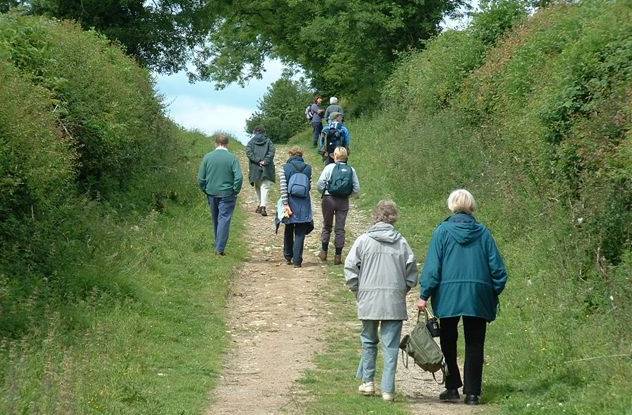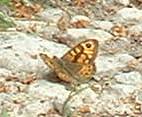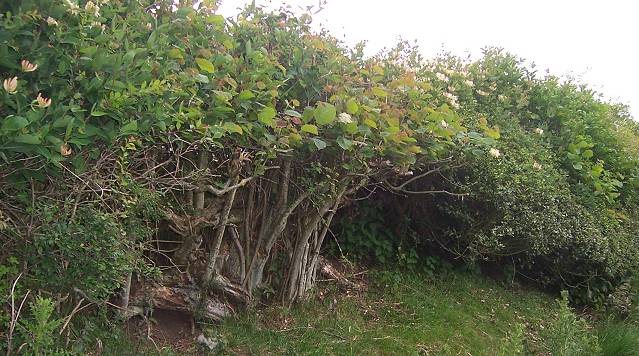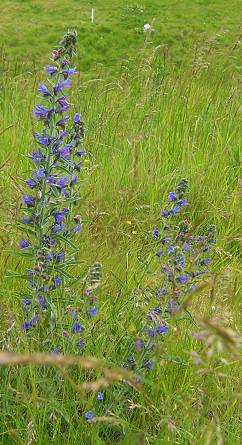
Back to the Index page
10 members met on the main street of Appleton-le-Moors at 10am. It was a generally sunny morning and although showers threatened, we were lucky and only got a few spots of rain. We began down South Ings Lane where the rich hedgerow was a mixture of Hawthorn, Field Maple, Elder, Ash, Blackthorn, Holly, Dogwood and Hazel with Blackberry, Gooseberry, Honeysuckle, Dog rose, Downy rose and Black bryony. The number of species, as well as the size and shape of many of the individual plants, strongly suggest this hedge is several hundred years old.

The fields either side of the lane run lengthways away from the village and are a mixture of arable and pasture. They follow very old property lines, and the curving nature of their boundaries may well reflect the medieval strips from the common fields. One such pasture was of interest as it had been sub-divided into three by post and rail fencing running widthways.
We had then planned to walk north along Ings Baulk and back to the village via the footpath but the area round Spaunton Quarry proved too tempting. Time constraints prevented us from reaching the field that has been given over to the Cornfields Flower Project on this occasion and we retraced our steps back to the village.
A small plantation of game cover on the edge of the quarry revealed an abundance of Tall Melilot, Wild Radish and what we suspected was Weld. Interestingly,  Viper’s Bugloss was growing on the steep grass slope on the western edge of the quarry. We were very grateful, as ever, for Nan’s valuable expertise and tuition. The plants seen are listed below.
Viper’s Bugloss was growing on the steep grass slope on the western edge of the quarry. We were very grateful, as ever, for Nan’s valuable expertise and tuition. The plants seen are listed below.
Several large white butterflies were seen, and one wall brown (left}. Of the birds Tom says “Could list the usual suspects but I think of interest were: Yellowhammers at least two singing males in the lane (they seem to be doing well this year) and plenty of sand martins in and around the quarry indicating a likely breeding colony there.”

| Englilsh Name | Latin Name |
|---|---|
| Ash | Fraxinus excelsior |
| Bird’s foot trefoil | Lotus corniculatus |
| Black bryony | Tamus communis |
| Black medick | Medicago lupulina |
| Blackthorn | Prunus spinosa |
| Bladder campion | Silene vulgaris |
| Bramble | Rubus fruticosus agg. |
| Bush vetch | Vicia sepium |
| Common mouse-ear | Cerastium fontanum |
| Common poppy | Papaver rhoeas |
| Cow parsley | Anthriscus sylvestris |
| Creeping buttercup | Ranunculus repens |
| Creeping thistle | Cirsium arvense |
| Crosswort | Cruciata laevipes |
| Cut-leaved cranesbill | Geranium dissectum |
| Daisy | Bellis perennis |
| Dandelion | Taraxacum agg. |
| Dog rose | Rosa canina |
| Dogwood | Cornus sanguinea |
| Dog’s mercury | Mercurialis perennis |
| Downy rose | Rosa mollis |
| Elder | Sambucus nigra |
| Field forgetmenot | Myosotis arvensis |
| Field maple | Acer campestre |
| Garlic mustard | Alliaria petiolata |
| Germander speedwell | Veronica chamaedrys |
| Gooseberry | Ribes uva-crispa |
| Ground ivy | Glechoma hederacea |
| Hawthorn | Crataegus monogyna |
| Hazel | Corylus avellana |
| Herb Robert | Geranium robertianum |
| Hogweed | Heracleum sphondylium |
| Holly | Ilex aquifolium |
| Honeysuckle | Lonicera periclymenum |
| Lesser stitchwort | Stellaria graminea |
| Lords and ladies | Arum maculatum (fruits on spikes still green) |
| Nettle | Urtica dioica |
| Pignut | Conopodium majus |
| Pineapple weed | Matricaria discoidea |
| Ribwort plantain | Plantago lanceolata |
| Shepherd’s purse | Capsella bursa-pastoris |
| Silverweed | Potentilla anserina |
| Spear thistle | Cirsium vulgare (not in flower) |
| Tall melilot | Melilotus altissimus |
| Viper’s bugloss | Echium vulgare |
| Weld | Reseda luteola |
| White clover | Trifolium repens |
| Wild radish | Raphanus raphanistrum |
| Wood avens | Geum urbanum |
 Viper’s Bugloss |
| Back to the top and Index page |
Text and photos © Tom and Janet Denney 2008 & Ryedale NHS